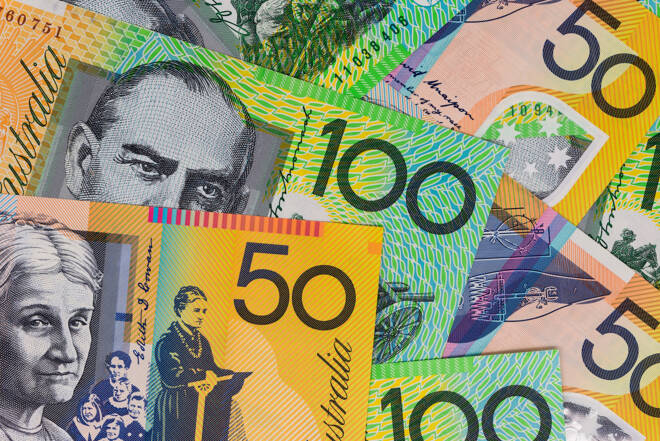Advertisement
Advertisement
AUD to USD Forecast: Australian Dollar Faces US Inflation and China’s Resilience
By:
Amidst China's easing deflation, the Aussie Dollar remains watchful of US consumer inflation shifts.
Highlights
- AUD/USD sees a slight dip, ending the week at $0.63743, preceding a decline of 0.07% on Thursday.
- The Aussie dollar faces downside risks despite China’s steadying economic indicators.
- US inflation anticipation grows; economists await the US CPI report, predicting a rise from 3.2% to 3.6%.
Friday Overview
On Friday, the AUD/USD slipped by 0.02%. Following a 0.07% loss on Thursday, the Aussie Dollar ended the day at $0.63743. The Australian Dollar fell to a low of $0.63670 before rising to a high of $0.64147.
China Inflation and Stimulus Hopes Offer Early Support
China and the Chinese economy remained the focal point this morning. Inflation figures released over the weekend offered some comfort as deflationary pressures eased.
The producer price index fell by 3.0% in August year-over-year versus a 4.4% decline in July. Consumer price inflationary pressures returned in August. Consumer prices increased by 0.1% year-over-year versus a 0.3% decline in July. Month-on-month, consumer prices rose by 0.3% versus +0.2% in the previous month.
With producer prices falling at the least marked pace since March (-2.5%), the latest inflation figures point to a steadying in the Chinese economy. However, downside risks for the Aussie dollar linger.
Later today, vehicle sales and new Yuan loan figures from China will also need consideration. The reports will give investors a snapshot of consumer demand and credit appetite. Economists forecast new loans to rise from CNY345.9 billion to CNY1,200 billion and for vehicle sales to increase by 2.0% in August. Vehicle sales fell by 1.4% in July.
China’s macroeconomic indicators significantly influence the AUD/USD. China buys roughly one-third of Australia’s exports, with Australia’s trade-to-GDP ratio near 50%. Increased economic activity in China boosts demand for Australian exports, bolstering the economy and the Australian dollar. Trade accounts for about 20% of Australia’s employment.
US Consumer Inflation Expectations Will Attract Attention
This afternoon, US inflation will be in the spotlight. The Consumer Inflation Expectations survey will draw interest. Economists expect a modest softening from 3.5% to 3.4% in August. A more marked softening would test market bets on further Fed rate hikes.
Significantly, the numbers precede the all-important US CPI report, out on Wednesday. In contrast to the survey, economists expect the US annual inflation rate to accelerate from 3.2% to 3.6% in August.
While inflation is a focal point this week, there are no FOMC member speeches relating to monetary policy to consider. The FOMC blackout period started on Saturday and will end on September 21.
Short-Term Forecast
An improving macroeconomic backdrop would provide Aussie dollar support. However, economic and monetary policy divergence remains in favor of the US dollar. US inflation figures will be the key drivers in the first half of the week. Additional stimulus measures from Beijing would help offset the impact of a rising trend in US consumer prices.
AUD/USD Price Action
Daily Chart
The AUD/USD sat above the $0.63854 support level and trend line this morning. However, the Aussie dollar remained below the 200-day and 50-day EMAs, sending bearish price signals.
Upbeat economic indicators from China would support further gains to bring $0.6450 and the $0.6490 resistance level into view. However, the AUD/USD would need more Beijing stimulus measures to eye a return to $0.65.
A pullback through the $0.63854 support level would bring the trend line into play. Hotter-than-expected consumer inflation expectation figures would weigh on the AUD/USD. A break below the trend line would give the bears a run at the $0.62749 support level.
The RSI reading (14-Daily) of 38.98 shows room for more downside before the AUD/USD enters oversold territory.
4-Hourly Chart
The AUD/USD sits below the 50-day and 200-day EMAs, sending bearish price signals. However, the latest inflation numbers from China supported a breakout from the $0.63854 support level. Avoiding a fallback through the support level would give the bulls a run at the 50-day EMA.
Better-than-expected economic indicators from China later today would support a breakout from the 50-day EMA to target $0.6450.
However, US inflation figures could reverse early gains. An unexpected rise in the consumer expectation figures would send the Aussie dollar through the $0.63854 support level. A return to $0.6350 would bring the trend line into play.
Considering the RSI (14-4H) at 48.40, the Aussie dollar has room to fall before entering oversold territory.
About the Author
Bob Masonauthor
With over 28 years of experience in the financial industry, Bob has worked with various global rating agencies and multinational banks. Currently he is covering currencies, commodities, alternative asset classes and global equities, focusing mostly on European and Asian markets.
Advertisement
